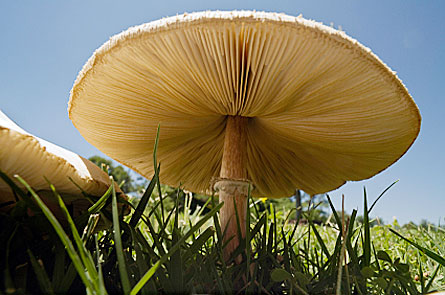Vitamin D-licious Mushrooms
Why some mushrooms are like the sun
 |
|
Scientists have figured out that exposing portabella mushrooms to sunlight can boost the fungis’ vitamin D amounts. |
| red_moon_rise/iStockphoto |
Over the past few years the sun has gotten a bad rap. Too much sunshine can put you at risk for skin cancer. And an overdose of sun can also lead to nasty sunburns, or even heatstroke.
But the sun isn’t always bad for the body. Scientists have known for years that the sun is a great source of vitamin D. This vitamin naturally boosts the immune system, your body’s defense against disease. Now mushrooms bathed in ultraviolet (UV) light — like that from the sun — can help you get some of this valuable vitamin.
Each year there are more and more studies released that suggest if you want to be healthy, vitamin D is where it’s at. Vitamin D strengthens your heart and bones, and can prevent asthma and some forms of cancer and diabetes.
Some foods, like fish and eggs, are naturally brimming with the vitamin. And others, like milk and some cereals, are fortified with vitamin D. But you would need to consume a lot of milk and cereal to get your daily dose of vitamin D. Sunlight still reigns king as the best source for vitamin D.
Recently scientists have shown that specially treated mushrooms could give people a vitamin D boost. U.S. Department of Agriculture researchers in California treated portabella mushrooms to suntanning sessions of up to 18 minutes. The mushrooms didn’t develop a bronze glow or complain of heat stroke though. Instead each mushroom produced nearly 4 micrograms of vitamin D per gram of tissue. When white mushrooms were given similar sun treatments, these fungi boasted extra vitamin D, too. Now both kinds of vitamin-infused ‘shrooms are on the market. So if you like mushrooms, you could munch your way to a higher daily dose of Vitamin D.
Depending on a person’s age, people should get between 5 and 15 micrograms (or 200 to 600 international units) of vitamin D each day. Without these amounts, people are prone to get diseases like rickets, which causes distorted, soft bones. These numbers, though, are really just a minimum. Now some scientists suggest it’s better to get as much as five times the recommended vitamin D dose each day.
Having more foods with Vitamin D is a good thing, since there are also several factors that make it hard to get enough of the vitamin from just the sun.
One factor influencing elderly people’s vitamin D intake is that they often spend less time outdoors. Therefore, they need more vitamin D in their diet. And if you spend a lot of your time indoors, playing video games or on the computer, you may need extra vitamin D from your food, too.
Skin color and weight also help determine a person’s vitamin D needs. Darker skin filters out more of the sun’s UV light, so people with darker skin need more sun exposure to make necessary amounts of vitamin D. For unknown reasons, heavier people also need a greater amount of UV light to enable vitamin D production.
And latitude — how far north or south you live — can play a major role in the sun’s ability to help you get adequate vitamin D amounts. As you get farther away from the equator, the amount of UV-filtering atmosphere increases. This means that at higher, more northern latitudes, people get less UV rays. So, if you live in a state like Alaska, most of the year you can’t get enough sun to trigger the vitamin’s production by your skin.
Eating foods enriched with vitamin D or taking a daily vitamin may not be as satisfying as breaking out your bathing suit and lying in the sun. But the right foods and supplements can help keep you healthy until summer’s rays are here again.
Going Deeper:







